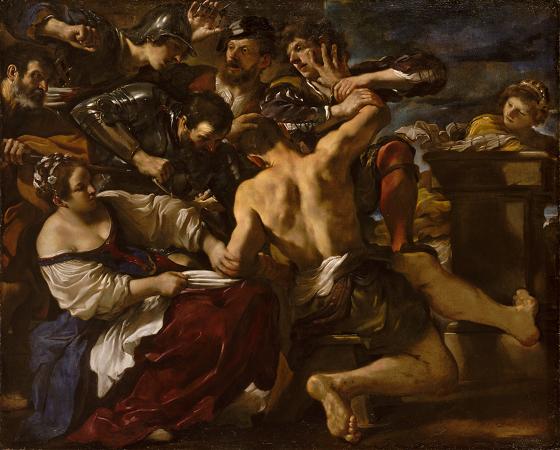Guercino (1591 - 1666). Giovanni Francesco Barbieri, better known as Guercino, or il Guercino, was an Italian Baroque painter and draftsman from Cento in the Emilia region, who was active in Rome and Bologna. The vigorous naturalism of his early manner contrasts with the classical equilibrium of his later works. His many drawings are noted for their luminosity and lively style. Giovanni Francesco Barbieri was born into a family of peasant farmers in Cento, a town in the Po Valley mid-way between Bologna and Ferrara. Being cross-eyed, at an early age he acquired the nickname by which he is universally known, Guercino. Mainly self-taught, at the age of 16, he worked as apprentice in the shop of Benedetto Gennari, a painter of the Bolognese School. An early commission was for the decoration with frescos of Casa Pannini in Cento, where the naturalism of his landscapes already reveals considerable artistic independence. In Bologna, he was winning the praise of Ludovico Carracci. He always acknowledged that his early style had been influenced by study of a Madonna painted by Ludovico Carracci for the Capuchin church in Cento, affectionately known as La Carraccina. His painting Et in Arcadia ego from around 1618-1622 contains the first known usage anywhere of the Latin motto, later taken up by Poussin and others, signifying that death lurks even in the most idyllic setting. The dramatic composition of this canvas is typical of Guercino's early works, which are often tumultuous in conception. He painted two large canvases, Samson Seized by Philistines and Elijah Fed by Ravens, for Cardinal Serra, a Papal Legate to Ferrara. Painted at a time when it is unlikely that Guercino could have seen Caravaggio's work in Rome, these works nevertheless display a starkly naturalistic Caravaggesque style. Guercino was recommended by Marchese Enzo Bentivoglio to the newly elected Bolognese Ludovisi Pope, Pope Gregory XV in 1621. The years he spent in Rome, 1621-23, were very productive. From this period are his frescoes Aurora at the casino of the Villa Ludovisi, the ceiling in San Crisogono of San Chrysogonus in Glory, the portrait of Pope Gregory XV, and the St. Petronilla Altarpiece for St. Peter's Basilica in the Vatican. Following the death of Gregory XV in 1623, Guercino returned to his hometown of Cento. In 1626, he began his frescoes in the Duomo of Piacenza. The details of his career after 1629 are well documented in the account book, the Libro dei Conti di Casa Barbieri, that Guercino and his brother Paolo Antonio Barbieri, a notable painter of still lifes, kept updated, and which has been preserved. Between 1618 and 1631, Giovanni Battista Pasqualini produced 67 engravings that document the early production of Guercino, which is not included in the Libro dei Conti. In 1642, following the death of his commercial rival Guido Reni, Guercino moved his busy workshop to Bologna, where he was now able to take over Reni's role as the city's leading painter of sacred subjects. Some of his later works are closer to the style of Reni, and are painted with much greater luminosity and clarity than his early works with their prominent use of chiaroscuro. In 1655, the Franciscan Order of Reggio paid him 300 ducats for the altarpiece of Saint Luke Displaying a Painting of the Madonna and Child. The Corsini also paid him 300 ducats for the Flagellation of Christ painted in 1657. Guercino was remarkable for the extreme rapidity of his executions: he completed no fewer than 106 large altarpieces for churches, and his other paintings amount to about 144. He was also a prolific draftsman. His production includes many drawings, usually in ink, washed ink, or red chalk. Most of them were made as preparatory studies for his paintings, but he also drew landscapes, genre subjects, and caricatures for his own enjoyment. Guercino's drawings are known for their fluent style in which rapid, calligraphic pen strokes combined with dots, dashes, and parallel hatching lines describe the forms. Guercino continued to paint and teach until his death in 1666, amassing a notable fortune. As he never married, his estate passed to his nephews and pupils, Benedetto Gennari II and Cesare Gennari. Other pupils include Giulio Coralli, Giuseppe Bonati of Ferrara, Cristoforo Serra of Cesena, Father Cesare Pronti of Ferrara, Sebastiano Ghezzi, Sebastiano Bombelli, Lorenzo Bergonzoni of Bologna, Francesco Paglia of Brescia., Benedetto Zallone of Cento, Bartolomeo Caravoglia, and Matteo Loves.
more...














